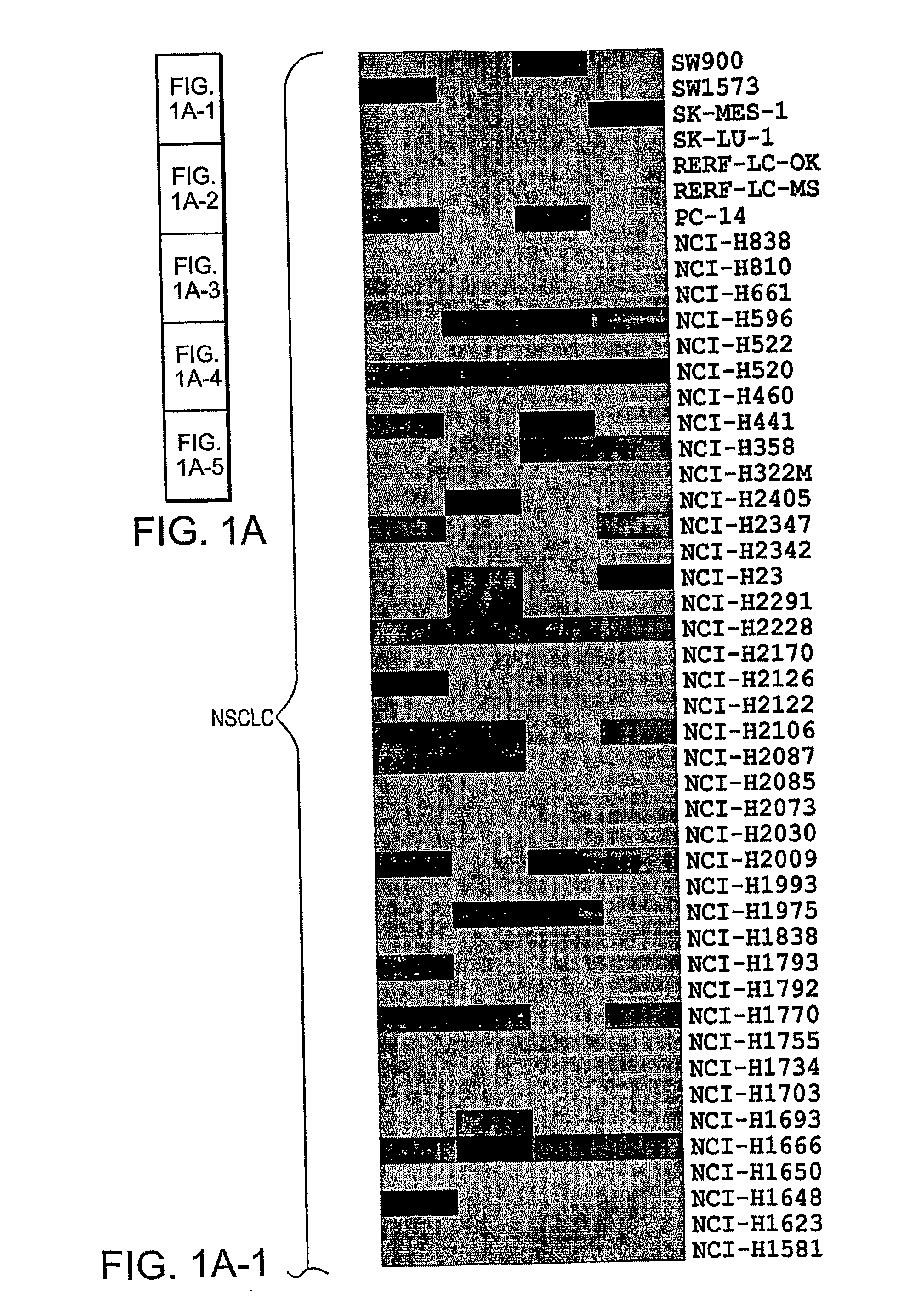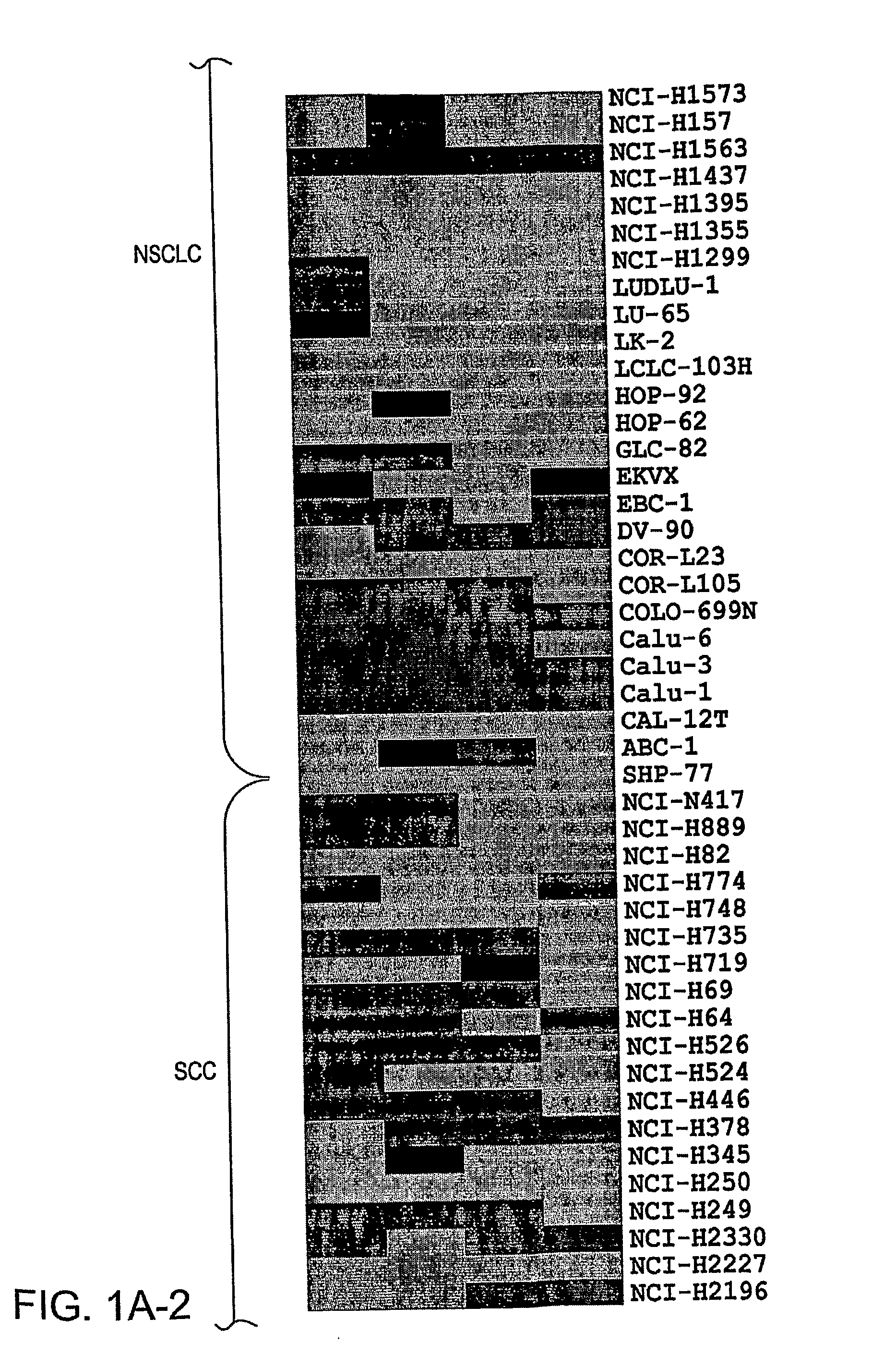Compositions and methods for the treatment or prevention of chemoresistant neoplasia
- Summary
- Abstract
- Description
- Claims
- Application Information
AI Technical Summary
Benefits of technology
Problems solved by technology
Method used
Image
Examples
example 1
KEAP-1 Mutation is a Frequent Genetic Alteration in Non-Small Cell Lung Carcinoma
[0142]A genome wide search for loss of heterozygosity (LOH) in lung cancer cell lines identified chromosome 19p as a candidate tumor suppressor region showing more than 60% loss of heterozygosity (Girard L et al. Cancer Res 6: 4894 (2000)). Evaluation of loss of heterozygosity at 19p13.2 in 191 lung cancer cell lines from the cancer genome project database at the Sanger Center, United Kingdom, revealed allelic losses in 38% of the cancer cell lines tested. Results are depicted in a heat map (FIG. 1A). Heat maps were constructed using GeneCluster and Treeview software (Eisen lab, Stanford, California). To determine whether mutations in the Keap1 gene KEAP1 are present in NSCLC, all 5 protein-coding exons and intron-exon boundaries of KEAP1 gene were amplified and sequenced in a set of 12 lung cancer cell lines. Table 1, shown below, is a summary of these results.
TABLE 1KEAP1 sequence alterations in lung ...
example 2
The Status of KEAP1 and Nrf2 is Altered in NSCLC
[0147]In this example, Keap1 and Nrf2 expression in NSCLC were characterized.
[0148]Consistent with the findings described above, which indicated a loss of functional KEAP1 in lung cancers, immunohistochemical staining of NRF2 in lung adenocarcinoma tissues showed increased staining in tumor tissue relative to the staining observed in paired normal tissue (FIG. 3A). NRF2 immunohistochemistry was carried out using the following methods.
[0149]Formalin fixed tissues were treated with anti-NRF2 antibody (H-300, Santa Cruz) at a dilution of 1:250 for 1 hour and developed using horseradish peroxidase (DAKO). Prominent NRF2 staining was detected in both the nucleus and cytoplasm of tumor tissue. Levels of known NRF2 targets in the samples were examined by measuring NAD(P)H dehydrogenase, quinone 1 (NQO1) and glutathione-S-transferases (GST) enzyme activities and total glutathione (GSH) levels in 13 pairs of primary NSCLC tumors and adjacent no...
example 3
Identification of siRNAs Targeting Nrf2
[0153]A number of 19 base pair siRNA duplexes for the human Nrf2 gene were designed using publicly available software from sites such as Qiagen, Ambion and Invitrogen. The Nrf2 mRNA sequence (accession number: NM—006164) was downloaded from the National Center for Biotechnology Information database, and putative siRNA oligomers were identified using these publicly available siRNA design sites. A list of sequences generated using the programs of a three different siRNA design sites was generated. The sequences were compared, and siRNA sequences present on all three lists were selected for further characterization. The selected sequences were used in a BLAST comparison against the human genome database. Only the sequences specifically targeting Nrf2 mRNA were selected, as described by SEQ ID NO: 1, SEQ ID NO: 2, SEQ ID NO:3, SEQ ID NO:4 below: All of the siRNA duplexes were synthesized by Dharmacon Research, Inc.
SEQ ID NO: 1Position in Nrf2 mRNA ...
PUM
| Property | Measurement | Unit |
|---|---|---|
| Time | aaaaa | aaaaa |
| Volume | aaaaa | aaaaa |
| Fraction | aaaaa | aaaaa |
Abstract
Description
Claims
Application Information
 Login to View More
Login to View More - R&D
- Intellectual Property
- Life Sciences
- Materials
- Tech Scout
- Unparalleled Data Quality
- Higher Quality Content
- 60% Fewer Hallucinations
Browse by: Latest US Patents, China's latest patents, Technical Efficacy Thesaurus, Application Domain, Technology Topic, Popular Technical Reports.
© 2025 PatSnap. All rights reserved.Legal|Privacy policy|Modern Slavery Act Transparency Statement|Sitemap|About US| Contact US: help@patsnap.com



